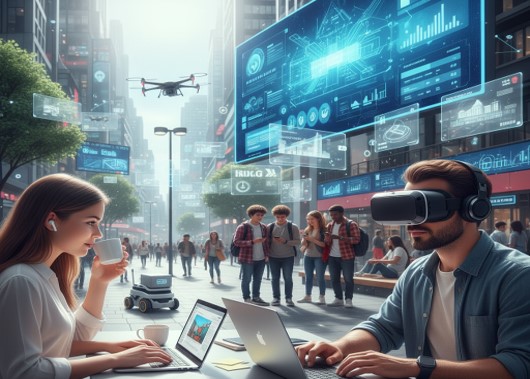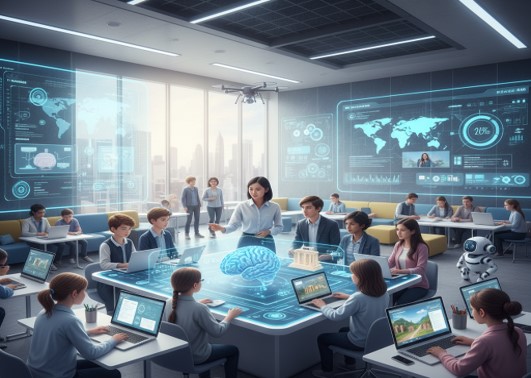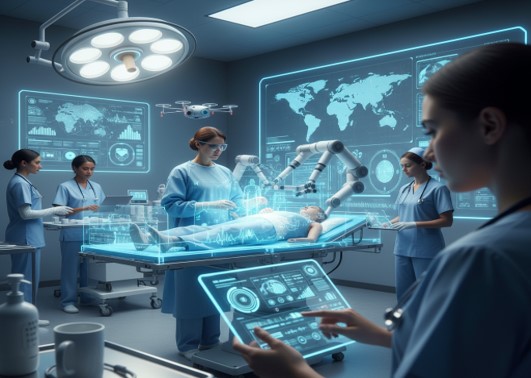Importance of Information and Technology in Modern Society
Information and Technology, often referred to as IT, is the use of computers, software, networks, and data systems to manage, store, process, and transmit information efficiently.
IT is the backbone that helps us collect, share, and analyze data — enabling faster decision-making and smarter communication.

Table of Contents
The Power of Information and Technology
In today’s world, information and technology (IT) have become inseparable parts of human life. From waking up to a smartphone alarm to attending virtual meetings or online classes, we are surrounded by the influence of technology every moment.
Information technology is the driving force behind global communication, digital transformation, and innovation. It has changed how we live, work, and think. Whether in education, healthcare, business, or governance, technology has created endless possibilities.
Information and technology have deeply influenced every aspect of human existence.
1. Introduction
In the 21st century, information and technology (IT) have become the driving forces behind nearly every aspect of human advancement. From revolutionizing education and communication to enhancing healthcare, business, and governance, IT has not only improved efficiency but also bridged gaps that once seemed insurmountable. As digital transformation accelerates globally, understanding the role of information and technology in our daily lives has never been more important.
2. Role of Information and Technology in Education

In the field of education, information and technology have revolutionized the way knowledge is delivered and accessed. Online learning platforms such as Coursera, Khan Academy, and Zoom have made it possible for students to learn from anywhere in the world, breaking down geographical and financial barriers. These technologies also provide access to vast digital libraries, e-books, and academic research papers, greatly expanding the resources available to learners and educators alike. Additionally, the use of multimedia tools and virtual classrooms has encouraged more interactive and engaging learning experiences, catering to different learning styles. For educators, technology simplifies administrative tasks by enabling efficient management of attendance, grades, and assignments through digital platforms, allowing them to focus more on teaching and student support.
3. Impact of IT on Communication
Information and technology have dramatically transformed the way we communicate, making global connectivity faster, easier, and more accessible than ever before. Tools such as email, video calls, and social media platforms have revolutionized how individuals and organizations interact, allowing real-time communication regardless of geographical boundaries. This advancement has significantly reduced the cost and time associated with traditional methods of communication, enabling instant messaging, virtual meetings, and file sharing with just a few clicks. Moreover, it has played a crucial role in strengthening both social and professional relationships, allowing people to stay connected with friends, family, and colleagues across the globe, while also supporting collaboration and networking in the workplace.
4. IT’s Role in Business and the Economy
In the realm of business and the economy, information technology plays a pivotal role in driving growth, innovation, and global connectivity. It powers essential services such as e-commerce, online banking, and digital marketing, enabling businesses to operate online and reach wider audiences with greater efficiency. Through automation tools, IT simplifies complex processes like accounting, payroll, and data management, reducing human error and saving valuable time and resources. Additionally, it has made remote work and global collaboration more feasible than ever, allowing teams from different parts of the world to work together seamlessly using cloud-based tools and communication platforms. For small businesses in particular, technology offers a powerful gateway to international markets, helping them attract and serve customers globally through online stores, social media, and digital advertising.
5. Advancements in Healthcare Through Technology

In the healthcare sector, information technology has brought about transformative changes that enhance both patient care and medical administration. Digital health records, telemedicine services, and AI-powered diagnostic tools have made healthcare more efficient, accurate, and accessible. Patients can now consult doctors remotely, monitor their health through wearable devices and mobile apps, and access medical services without needing to visit clinics in person—especially valuable in rural or underserved areas. Furthermore, technology accelerates medical research and enables precise data analysis, leading to faster breakthroughs in treatments and improved disease management. Healthcare management has also seen significant improvements, with IT systems reducing paperwork, minimizing human error, and streamlining tasks such as scheduling, billing, and inventory control, ultimately leading to safer and more organized healthcare delivery.
6. Technology in Government and Public Administration
Information technology has significantly modernized government and administrative functions by promoting e-governance and enhancing transparency in public services. Through online portals and mobile applications, citizens can now easily access government schemes, submit applications, retrieve official documents, and participate in governance with greater ease and accountability. Initiatives such as digital identification systems, online tax filing, and smart city projects rely heavily on IT infrastructure to function efficiently. These advancements not only simplify bureaucratic processes but also reduce opportunities for corruption by minimizing direct human interaction and increasing data traceability. As a result, government operations become more streamlined, accessible, and citizen-centric, ultimately fostering trust and improving service delivery across various levels of administration.
7. Information and Technology in Everyday Life
In everyday life, information and technology have seamlessly integrated into our routines, making daily tasks more convenient and efficient. Smart devices such as Alexa, Google Home, and wearable technology like fitness trackers help users manage their schedules, monitor their health, and control home appliances with simple voice commands or smartphone apps. Online shopping platforms, food delivery apps, and digital payment systems have dramatically reduced the time and effort needed for basic errands, offering speed, variety, and comfort at our fingertips. Additionally, social networking sites and digital entertainment platforms like YouTube, Netflix, and Instagram provide opportunities for global engagement, allowing people to connect, share, and enjoy content from around the world. These innovations not only enhance convenience but also reshape how we interact with the world on a daily basis.
8. Challenges and Concerns
Despite its many benefits, the rapid growth of information and technology brings with it several challenges. Cybersecurity threats, data privacy concerns, and digital addiction are growing problems that must be addressed. The digital divide—where sections of the population lack access to basic technology—continues to hinder equitable development. Moreover, the increasing reliance on automation and artificial intelligence raises ethical questions about job displacement and machine accountability. It is essential that governments, businesses, and individuals work together to create policies and systems that ensure technology is used responsibly and inclusively.
9. The Future of Information and Technology
Looking ahead, information and technology will continue to shape the future in unprecedented ways. With advancements in artificial intelligence, quantum computing, and the Internet of Things (IoT), society is on the brink of a new technological era. These innovations promise to make systems smarter, more efficient, and increasingly interconnected. However, the success of this future depends on how we balance innovation with regulation, ensuring that technology serves humanity rather than replacing it.
Conclusion
Information and technology have become the backbone of modern civilization. They empower education, revolutionize communication, drive economic growth, improve healthcare outcomes, and enhance governance. While there are challenges to navigate, the potential for positive transformation is vast. As we move further into the digital age, it is vital to harness the power of IT wisely, ensuring it continues to uplift individuals, communities, and nations alike.
Vocabulary Chart with Hindi Meanings
English Word/Phrase | Meaning in English | Hindi Meaning (हिंदी अर्थ) |
Revolutionize | To completely change something for the better | क्रांतिकारी परिवर्तन करना |
Access | The ability to reach or use something | पहुँच / उपयोग करना |
Digital Libraries | Online collections of books and academic resources | डिजिटल पुस्तकालय |
Multimedia Tools | Tools using text, audio, images, animation, or video | मल्टीमीडिया उपकरण |
Virtual Classrooms | Online spaces where students and teachers interact | वर्चुअल कक्षा |
Administrative Tasks | Routine duties like managing attendance, records, etc. | प्रशासनिक कार्य |
Global Connectivity | The ability to connect with people around the world | वैश्विक जुड़ाव |
Real-time Communication | Instant exchange of information | वास्तविक समय में संचार |
Strengthen Relationships | To make relationships stronger | संबंध मजबूत करना |
E-commerce | Buying and selling products online | ई-कॉमर्स / ऑनलाइन व्यापार |
Automation | Use of technology to perform tasks without human input | स्वचालन / स्वचालित प्रणाली |
Remote Work | Working from outside a traditional office, often from home | दूरस्थ कार्य / घर से काम |
Global Collaboration | Working together across countries | वैश्विक सहयोग |
Digital Marketing | Promoting products or services using digital channels | डिजिटल विपणन / ऑनलाइन प्रचार |
Digital Health Records | Electronic version of a patient’s medical history | डिजिटल स्वास्थ्य रिकॉर्ड |
Telemedicine | Remote diagnosis and treatment through technology | दूरस्थ चिकित्सा |
Wearable Devices | Electronic gadgets worn on the body (e.g., fitness bands) | पहनने योग्य उपकरण (जैसे फिटनेस बैंड) |
Medical Research | Scientific study to improve healthcare | चिकित्सीय अनुसंधान |
Data Analysis | Examining data to draw useful insights | आंकड़ों का विश्लेषण |
E-governance | Use of IT in government services | ई-शासन / डिजिटल सरकारी सेवाएं |
Transparency | Openness and honesty in processes | पारदर्शिता |
Digital ID | A digital form of identification (like Aadhaar) | डिजिटल पहचान पत्र |
Online Tax Filing | Paying taxes through online portals | ऑनलाइन कर दाखिल करना |
Smart City Projects | Cities using technology for better services | स्मार्ट सिटी परियोजनाएँ |
Corruption Reduction | Decreasing illegal or dishonest behavior | भ्रष्टाचार में कमी |
Cybersecurity | Protection of internet-connected systems from attacks | साइबर सुरक्षा |
Digital Divide | The gap between people with and without access to technology | डिजिटल अंतर / तकनीकी असमानता |
Artificial Intelligence (AI) | Machines simulating human intelligence | कृत्रिम बुद्धिमत्ता |
Ethical Concerns | Moral issues or questions | नैतिक चिंताएँ |
Digital Transformation | Integration of digital tech in all areas of life | डिजिटल परिवर्तन |
Smart Devices | Gadgets like Alexa, Google Home, smartwatches, etc. | स्मार्ट डिवाइस |
Wearable Tech | Technology you can wear (e.g., smartwatches, fitness bands) | पहनने योग्य तकनीक |
Online Shopping | Purchasing goods via the internet | ऑनलाइन खरीदारी |
Food Delivery Apps | Apps used to order food at home | भोजन वितरण ऐप्स |
Digital Payments | Paying money electronically via apps or cards | डिजिटल भुगतान |
Entertainment Platforms | Websites or apps for movies, music, etc. | मनोरंजन प्लेटफ़ॉर्म |
Global Engagement | Interacting with people worldwide | वैश्विक सहभागिता |
Efficiency | Doing something well with minimal waste | दक्षता |